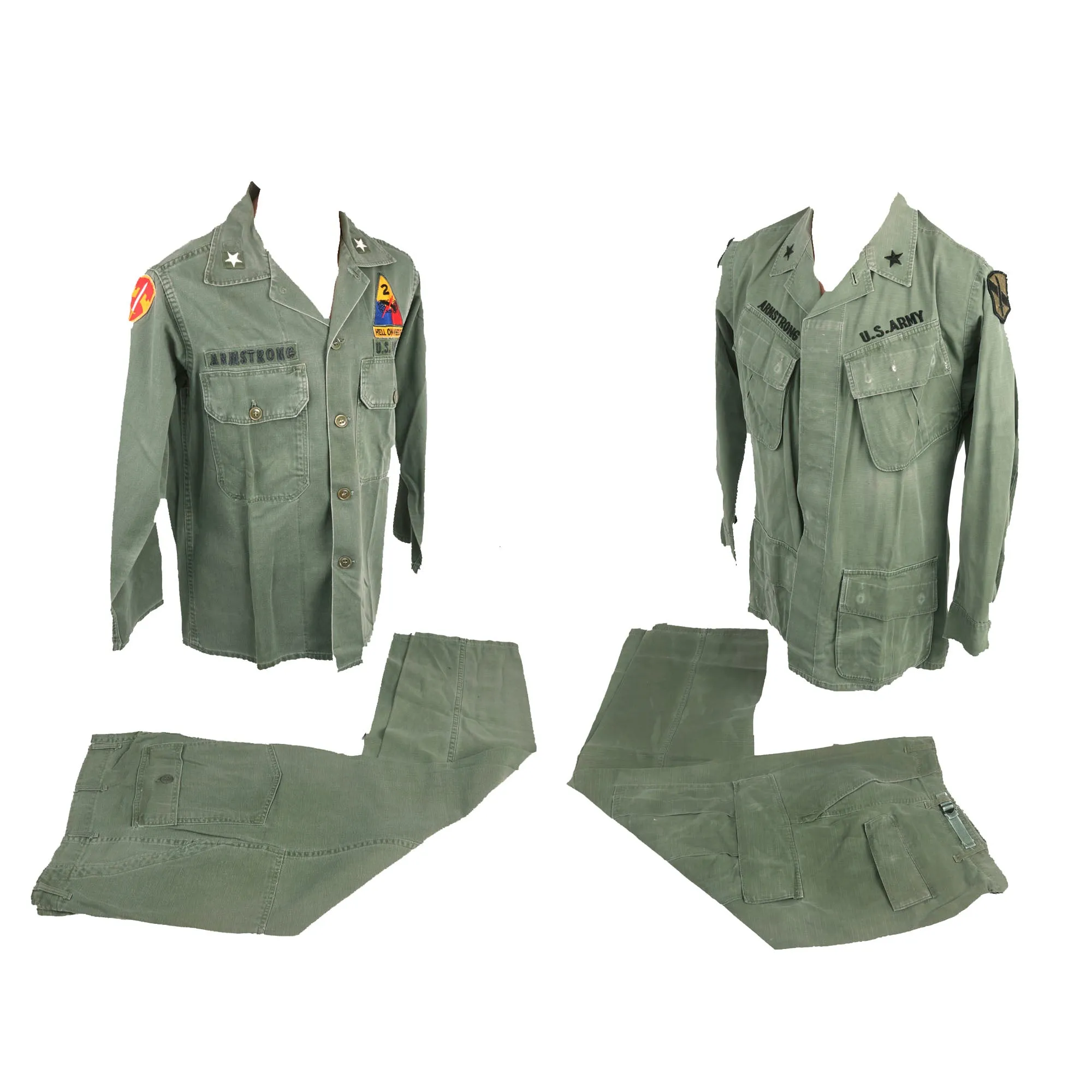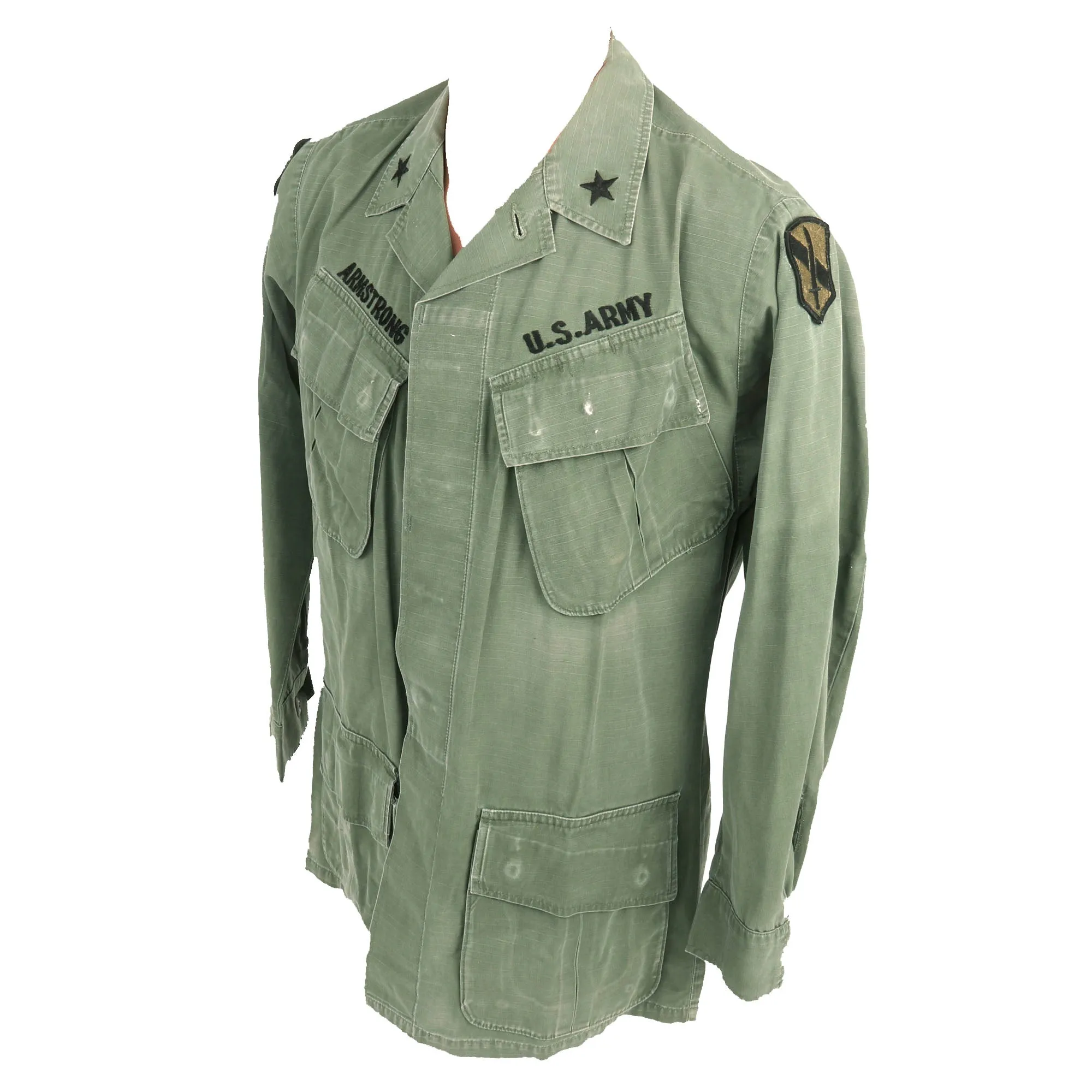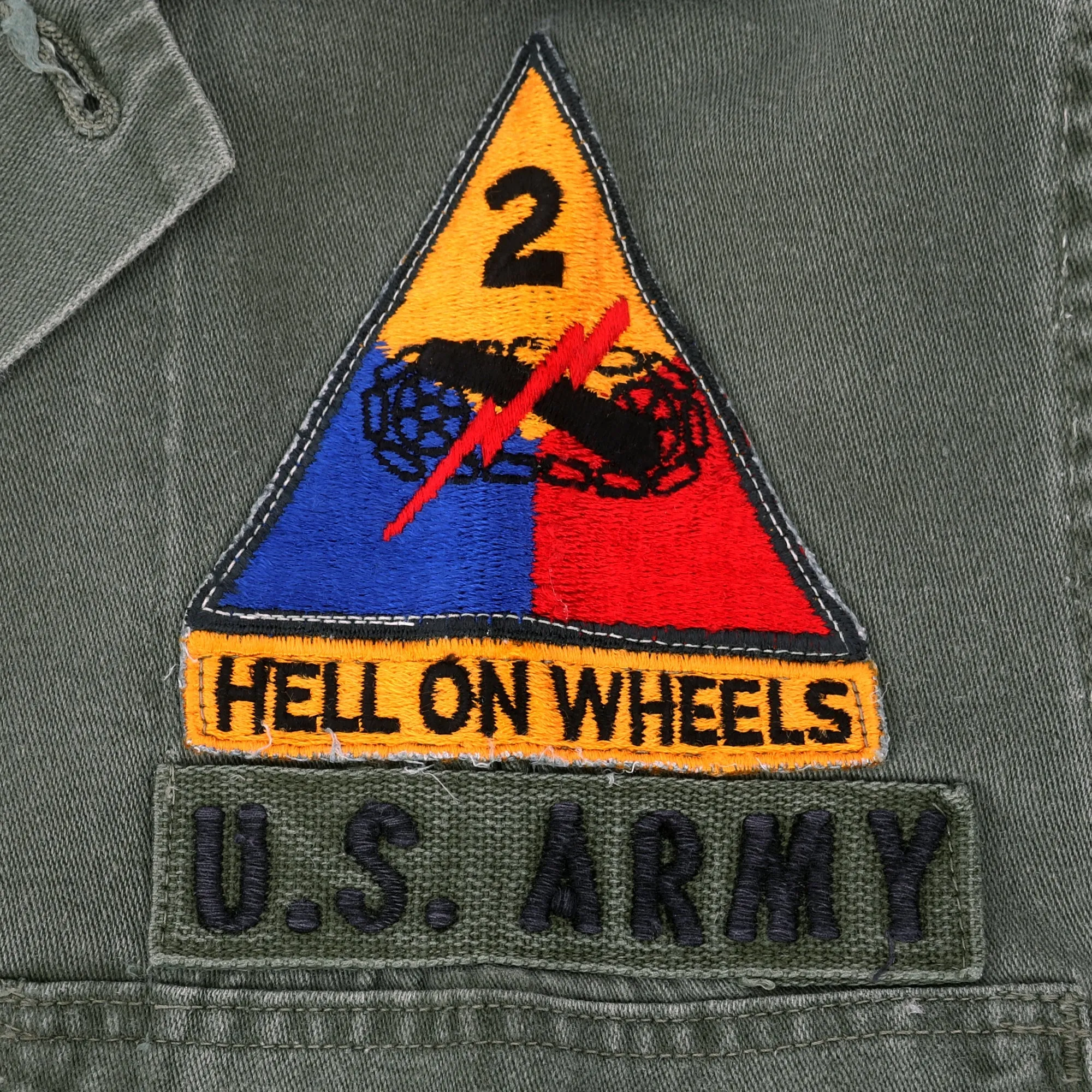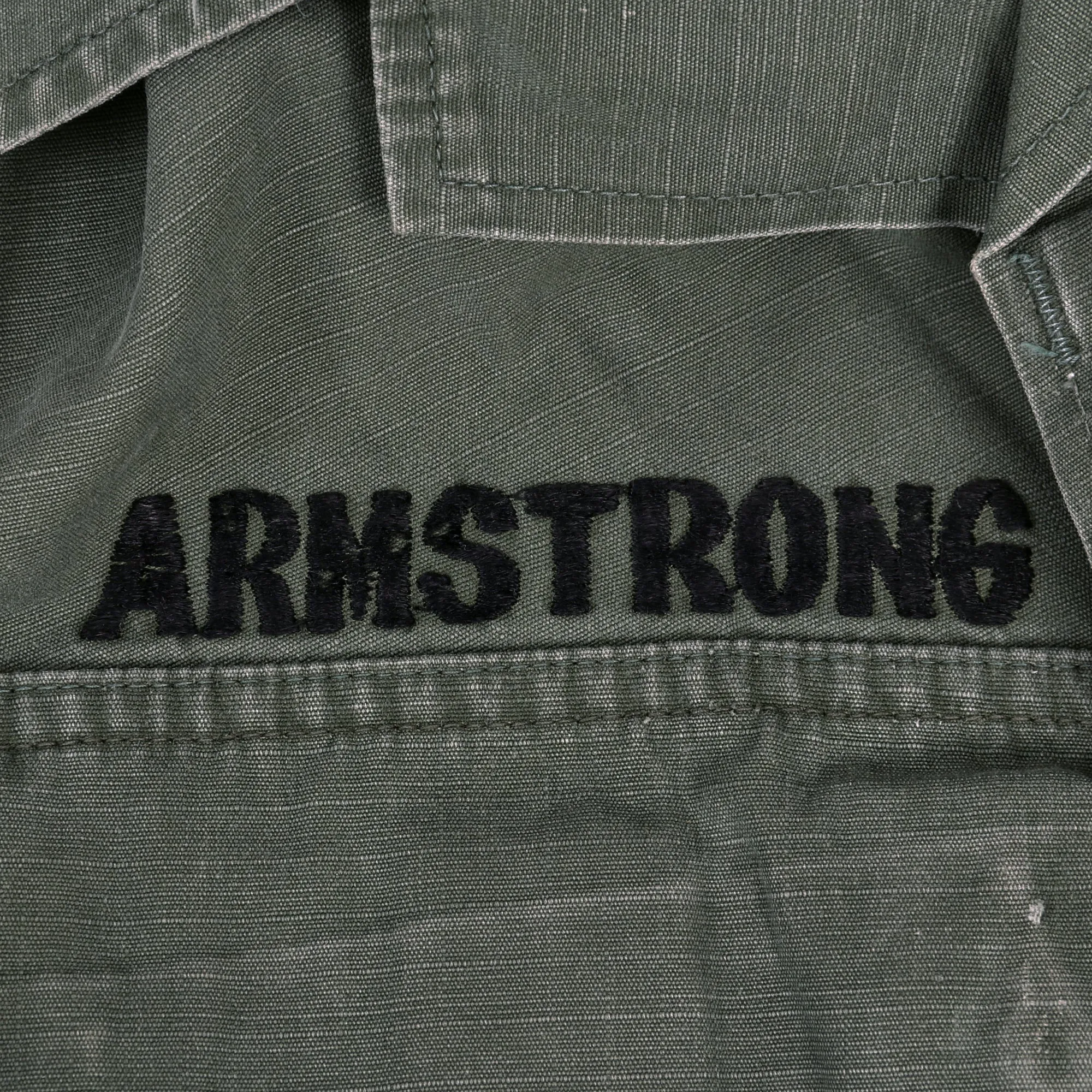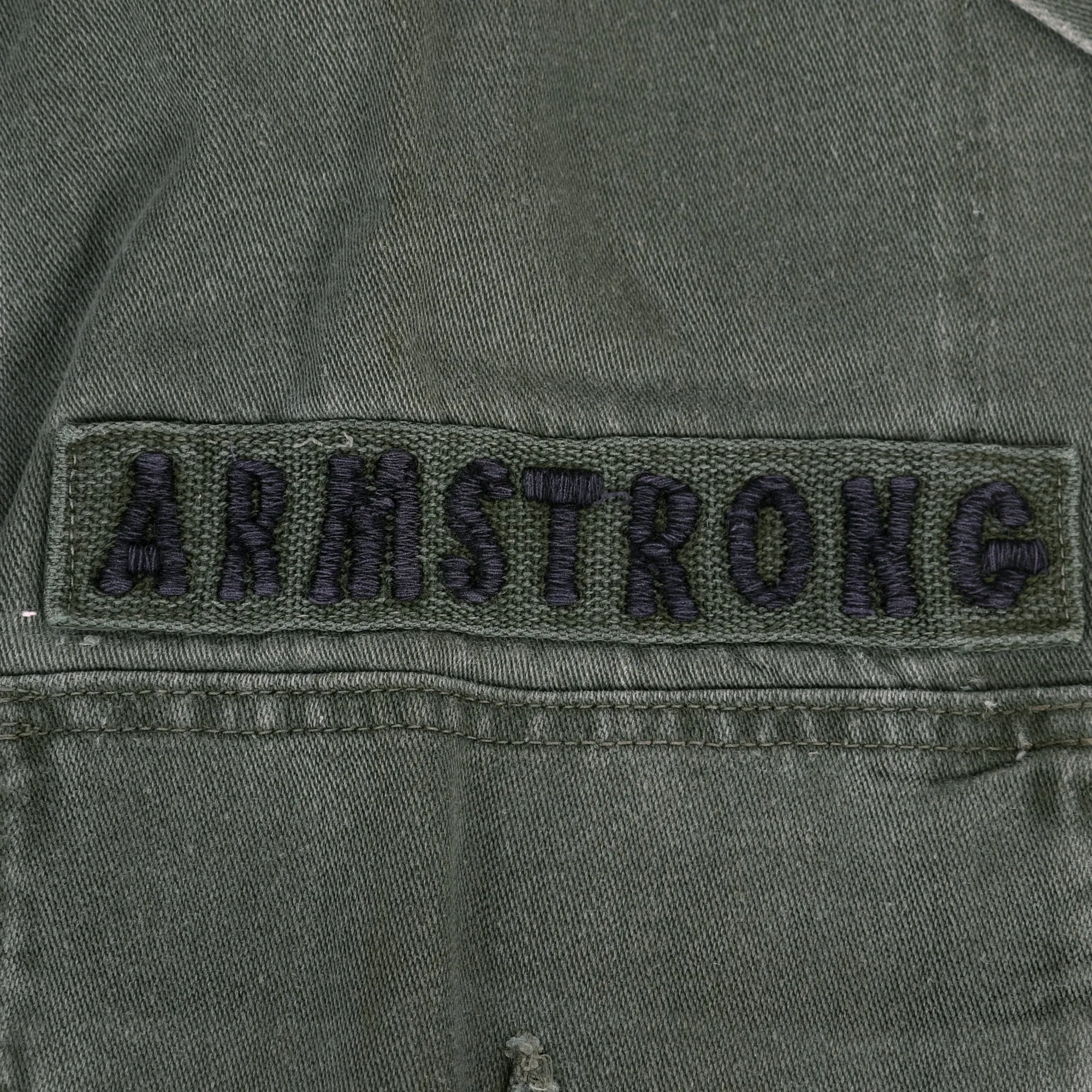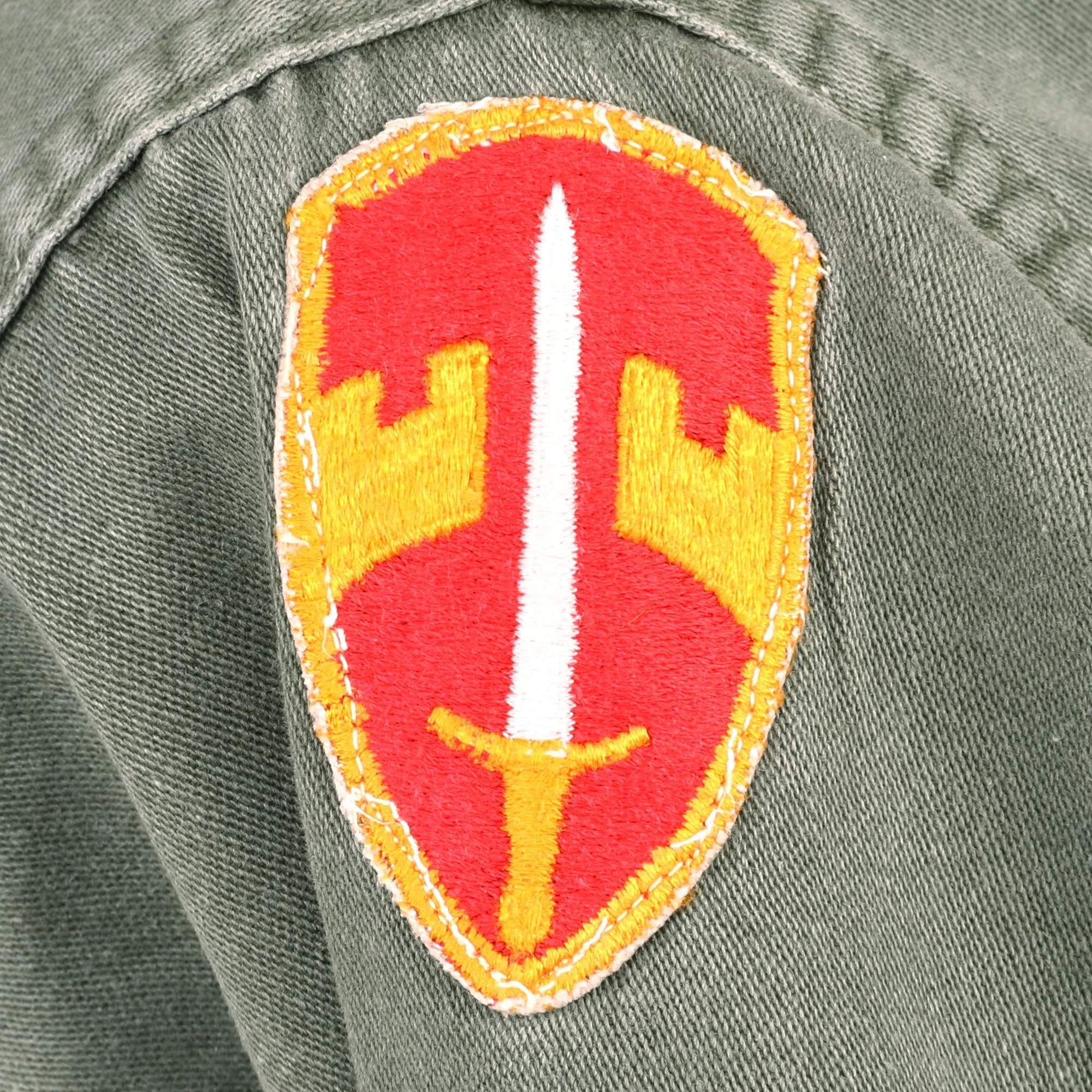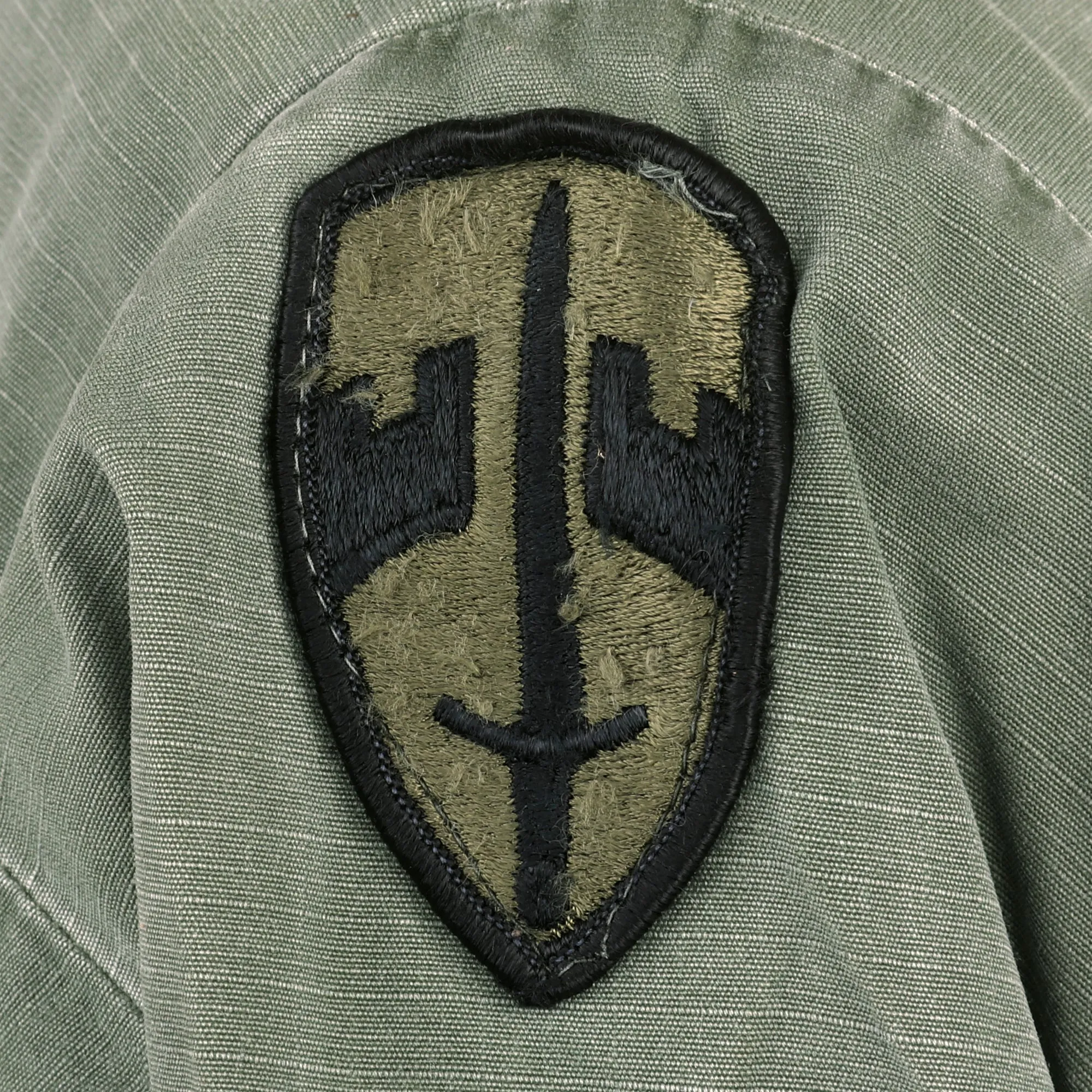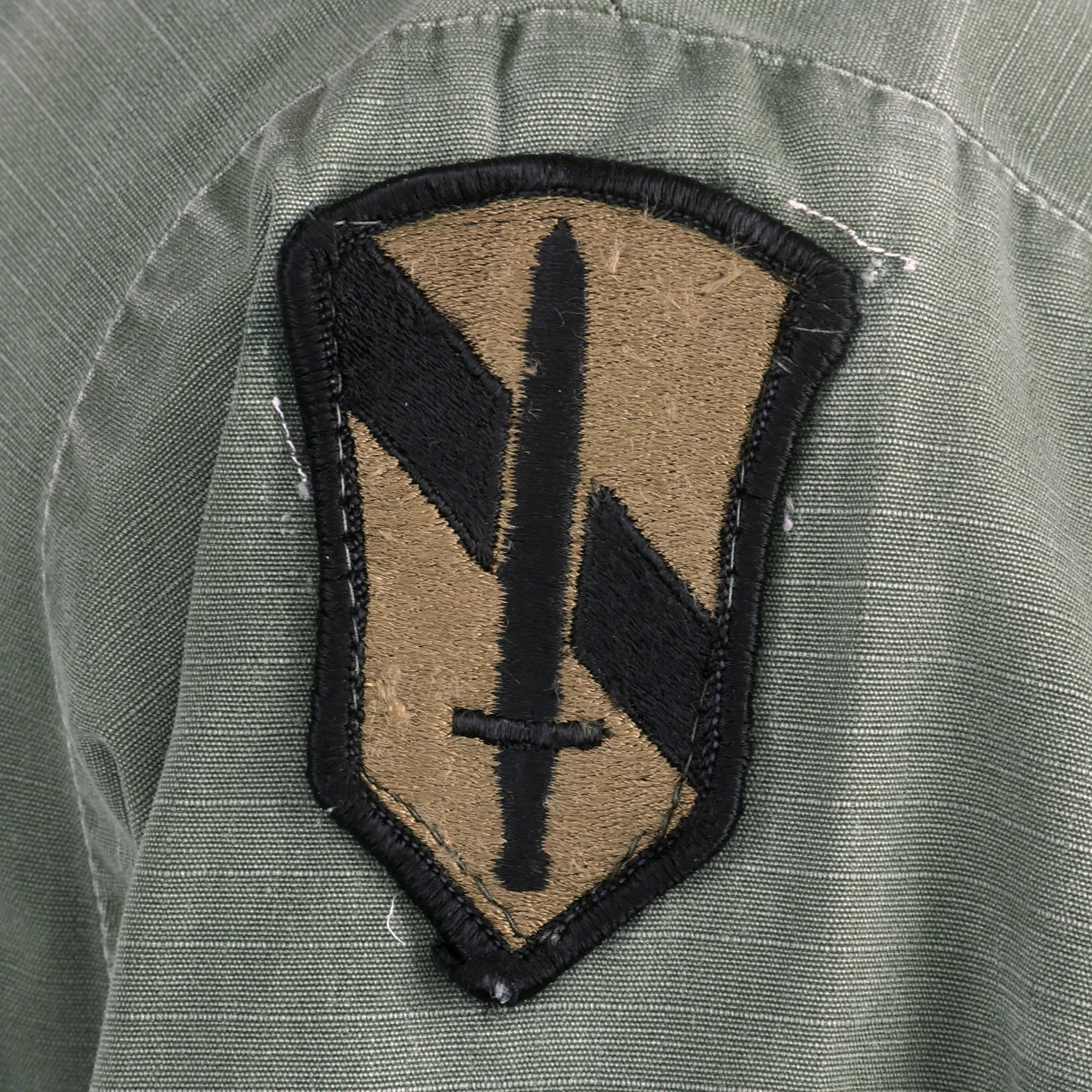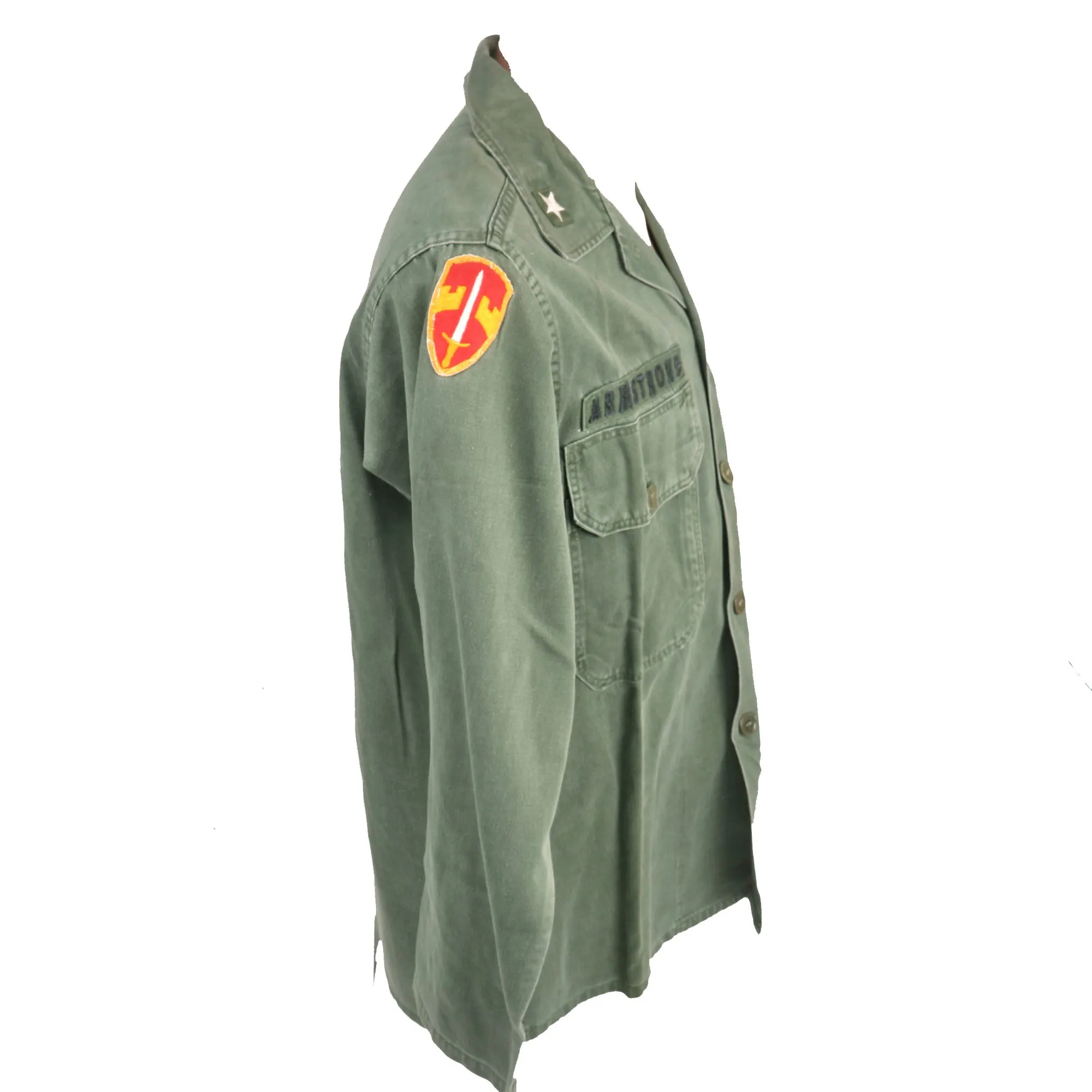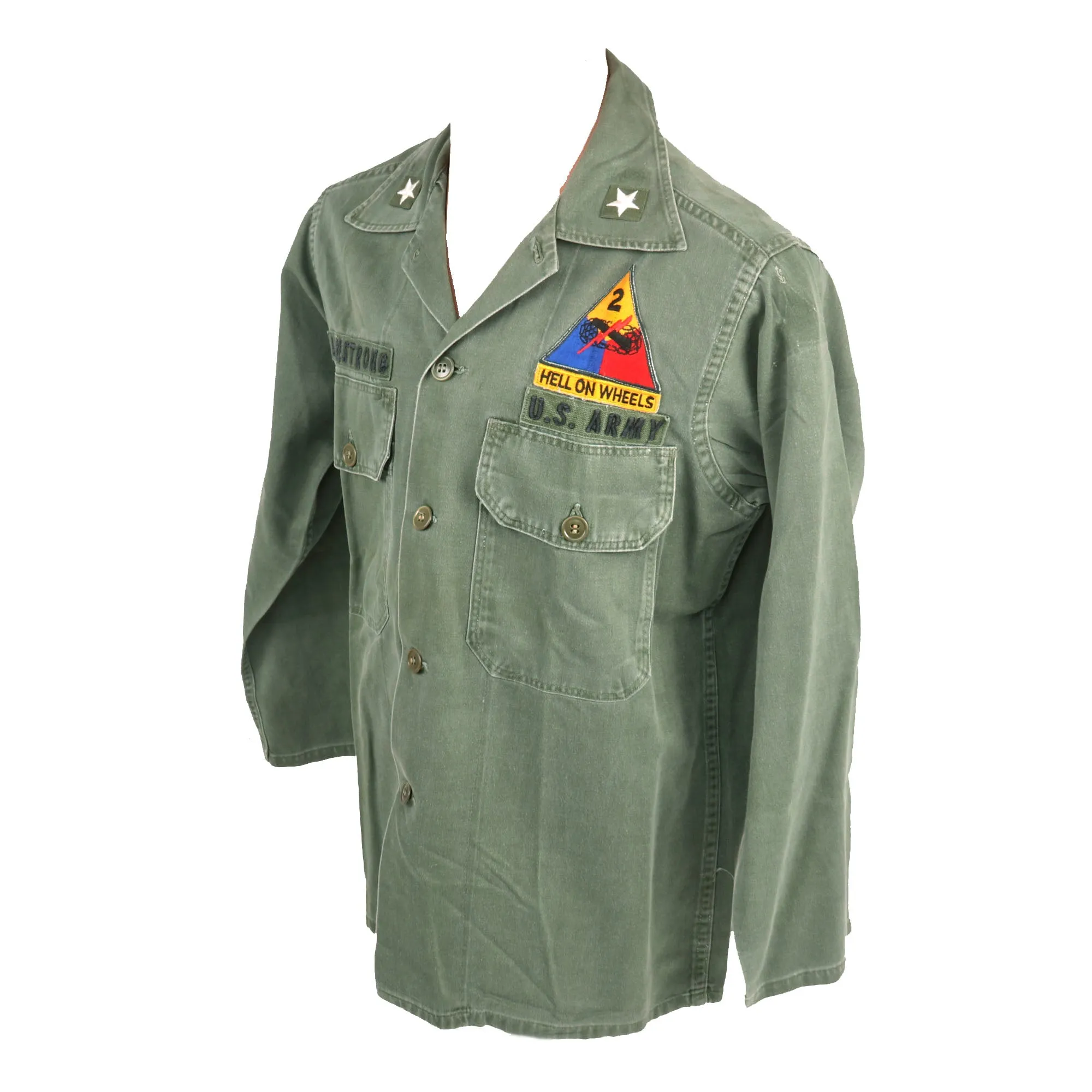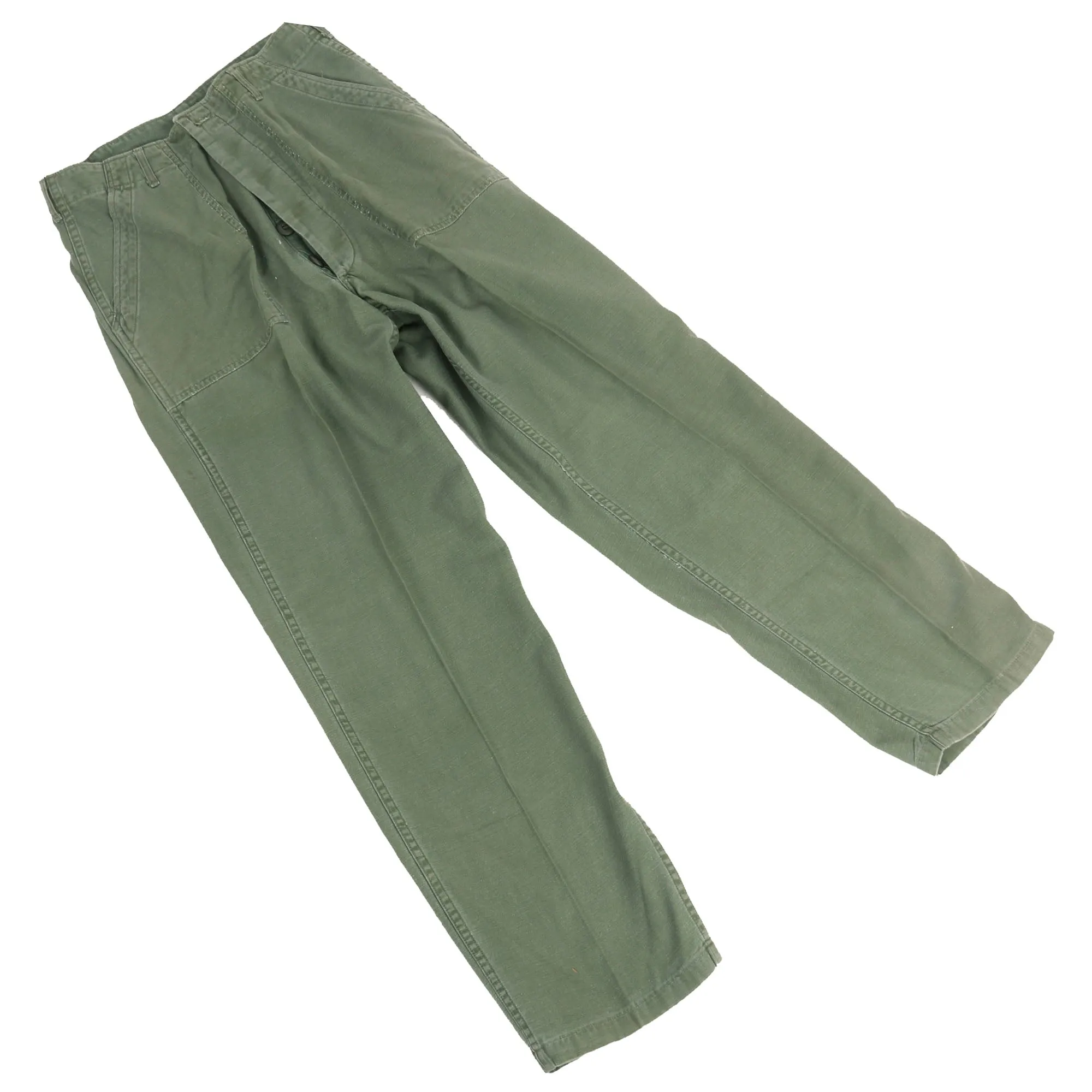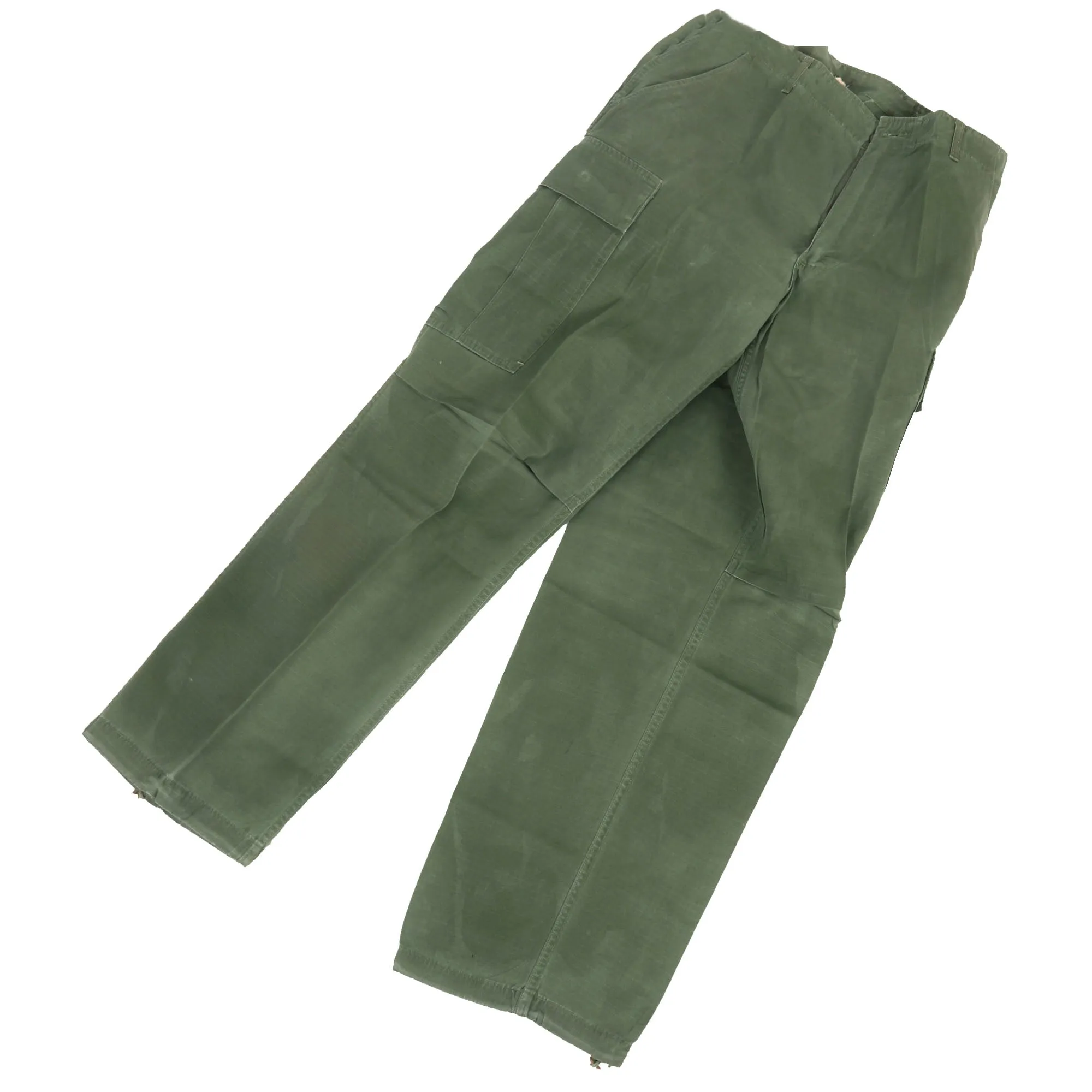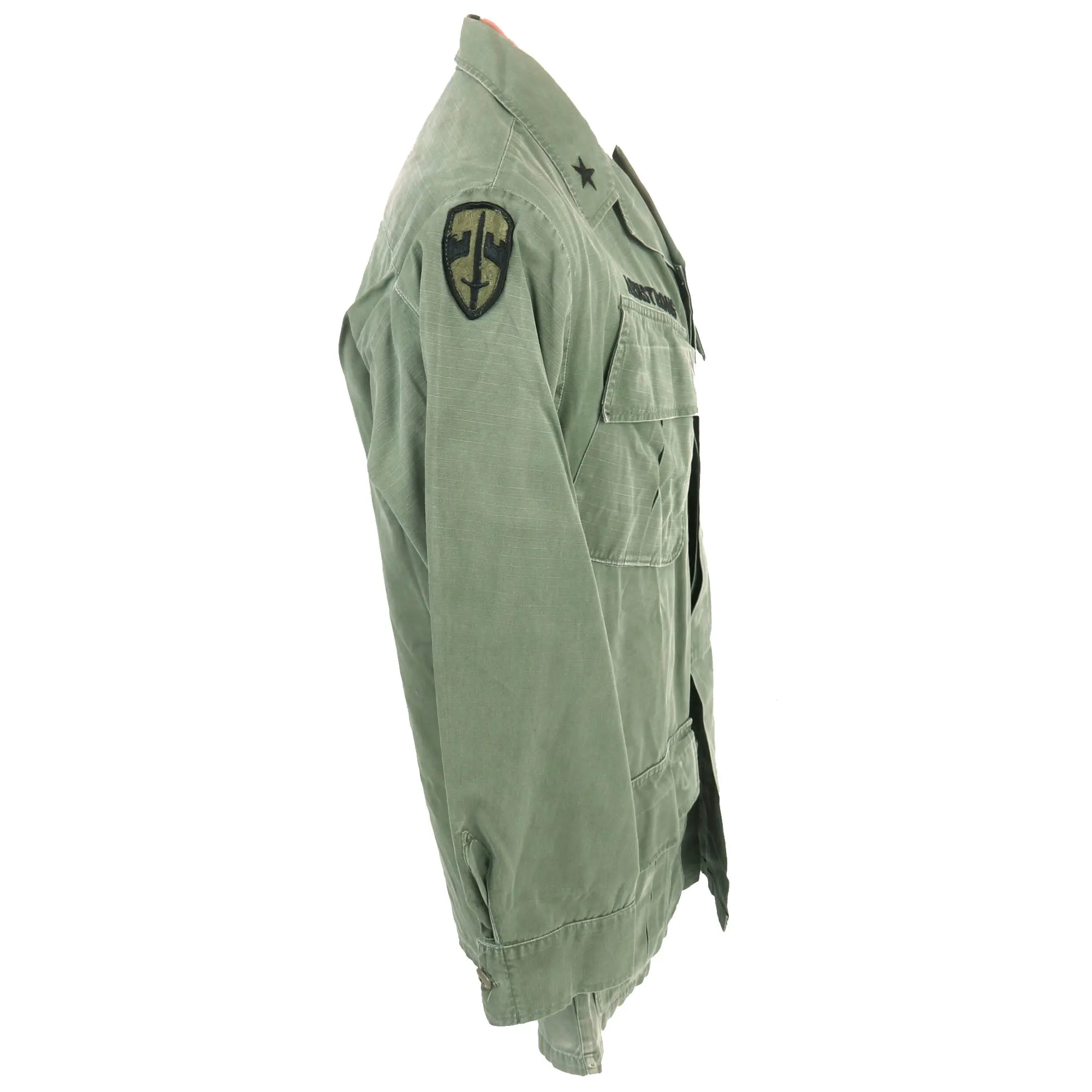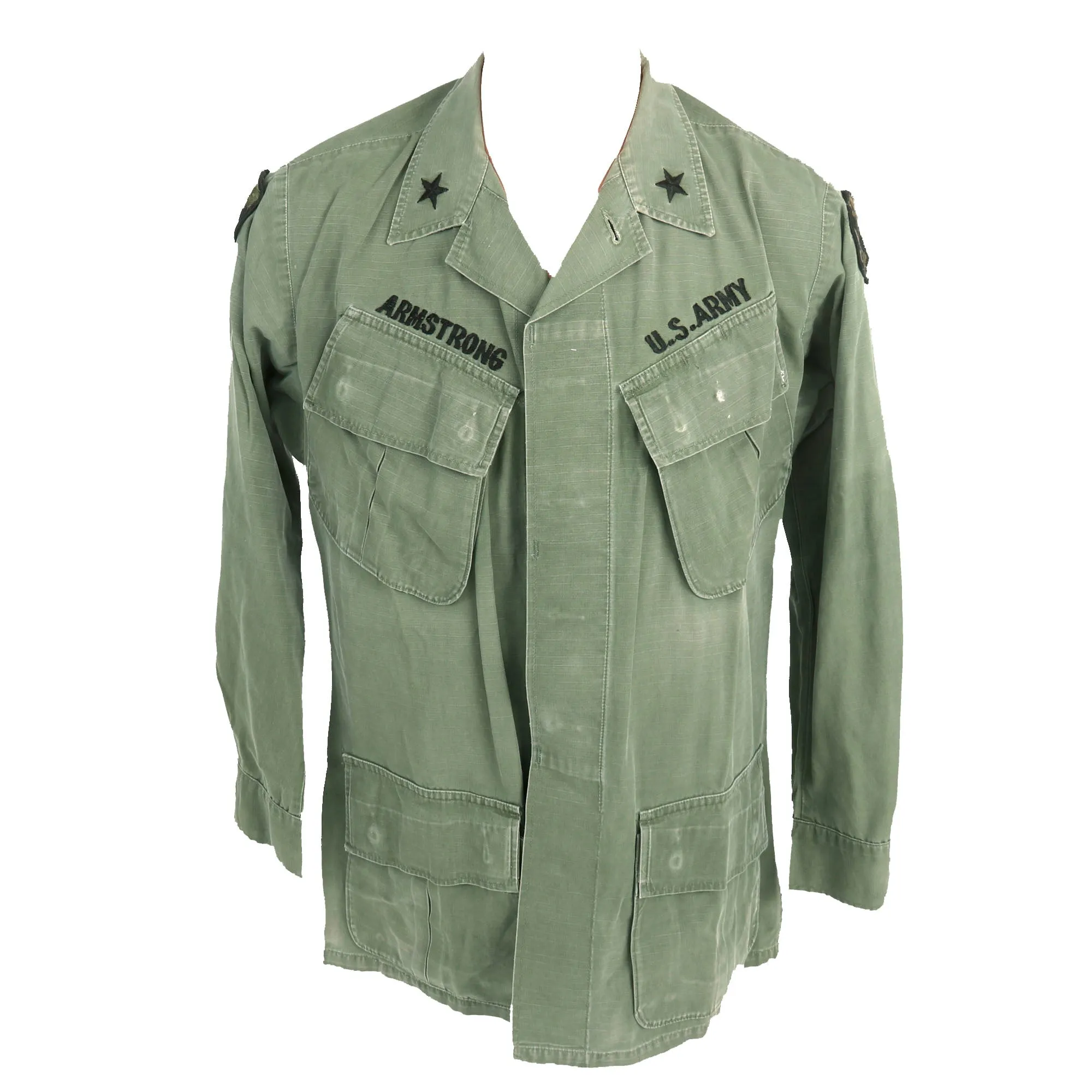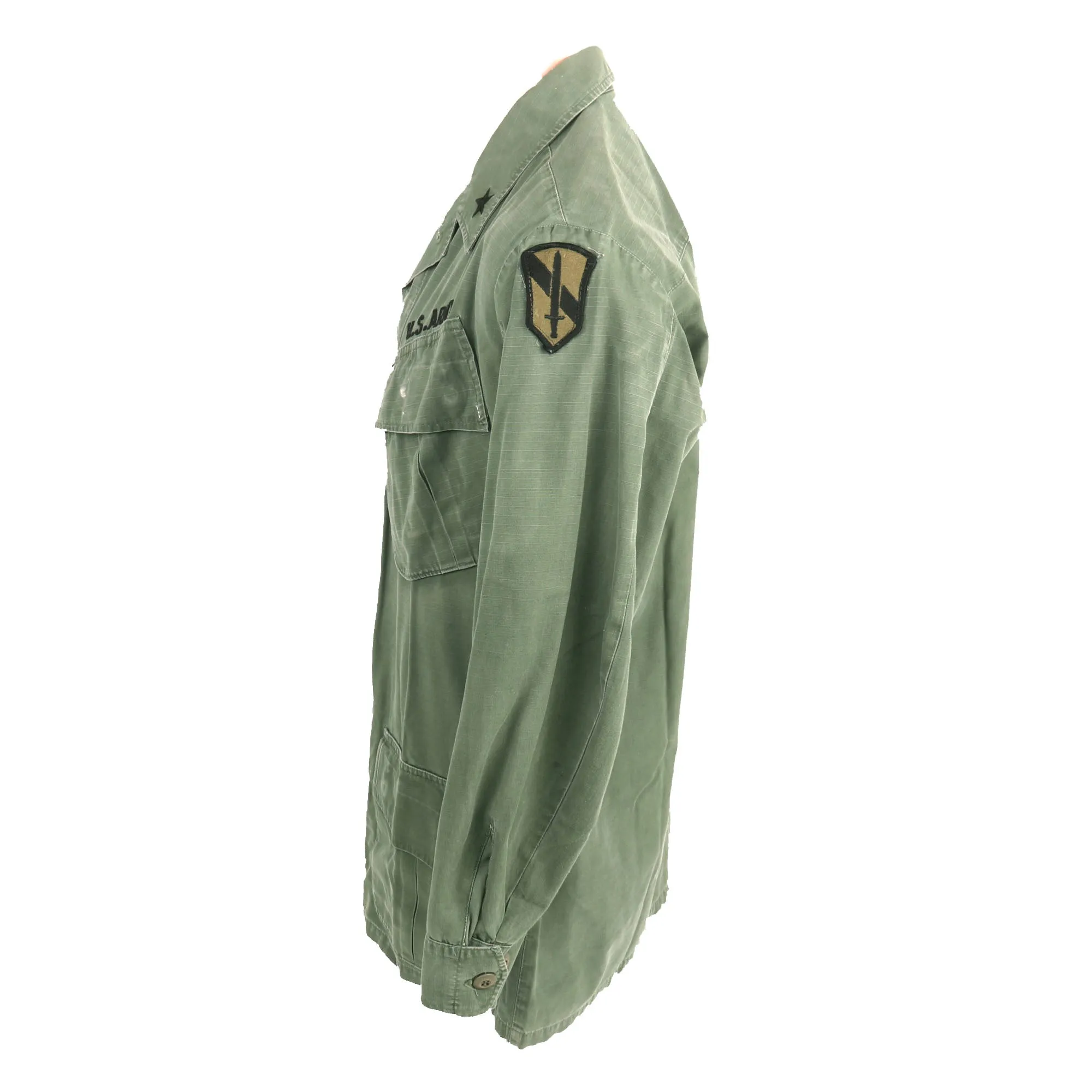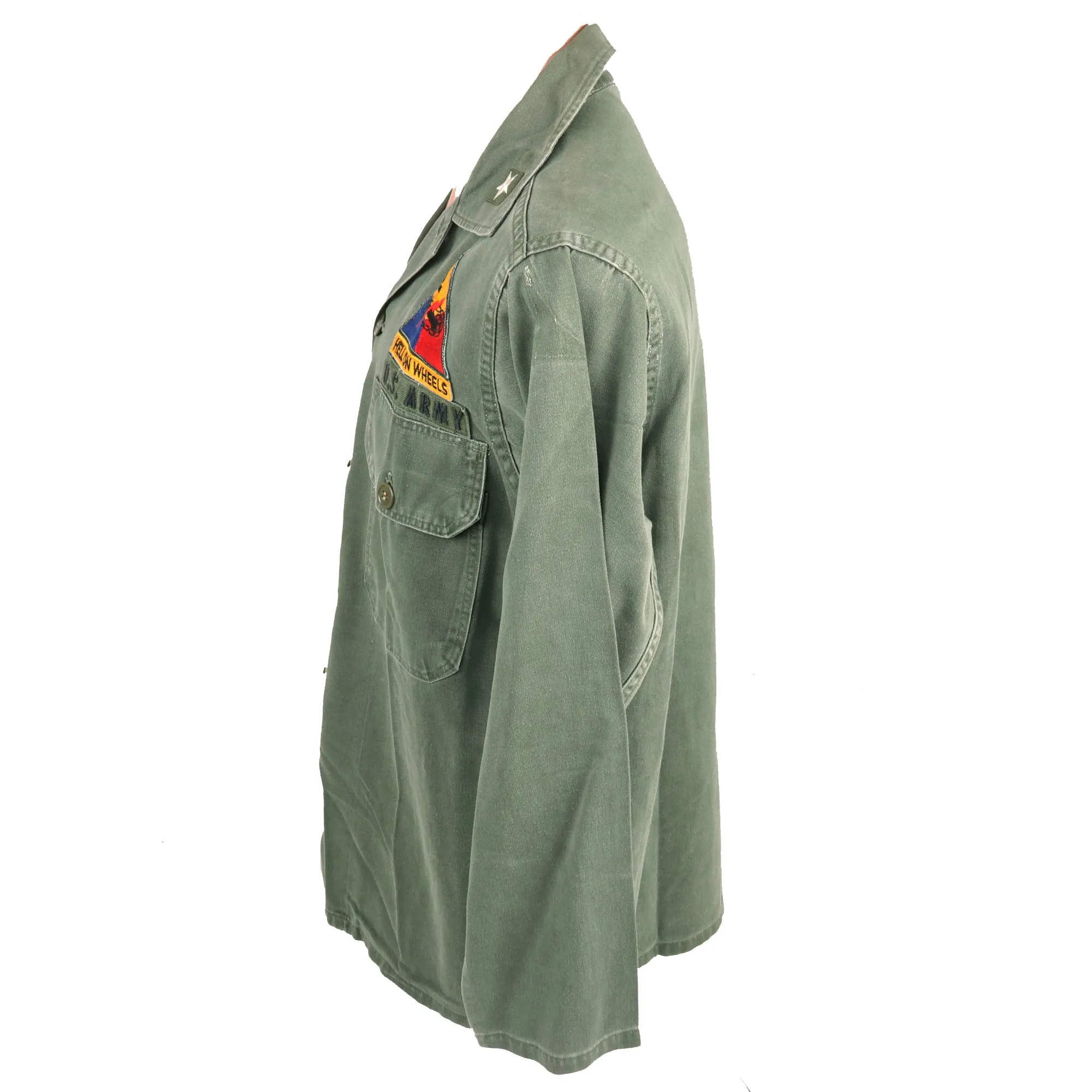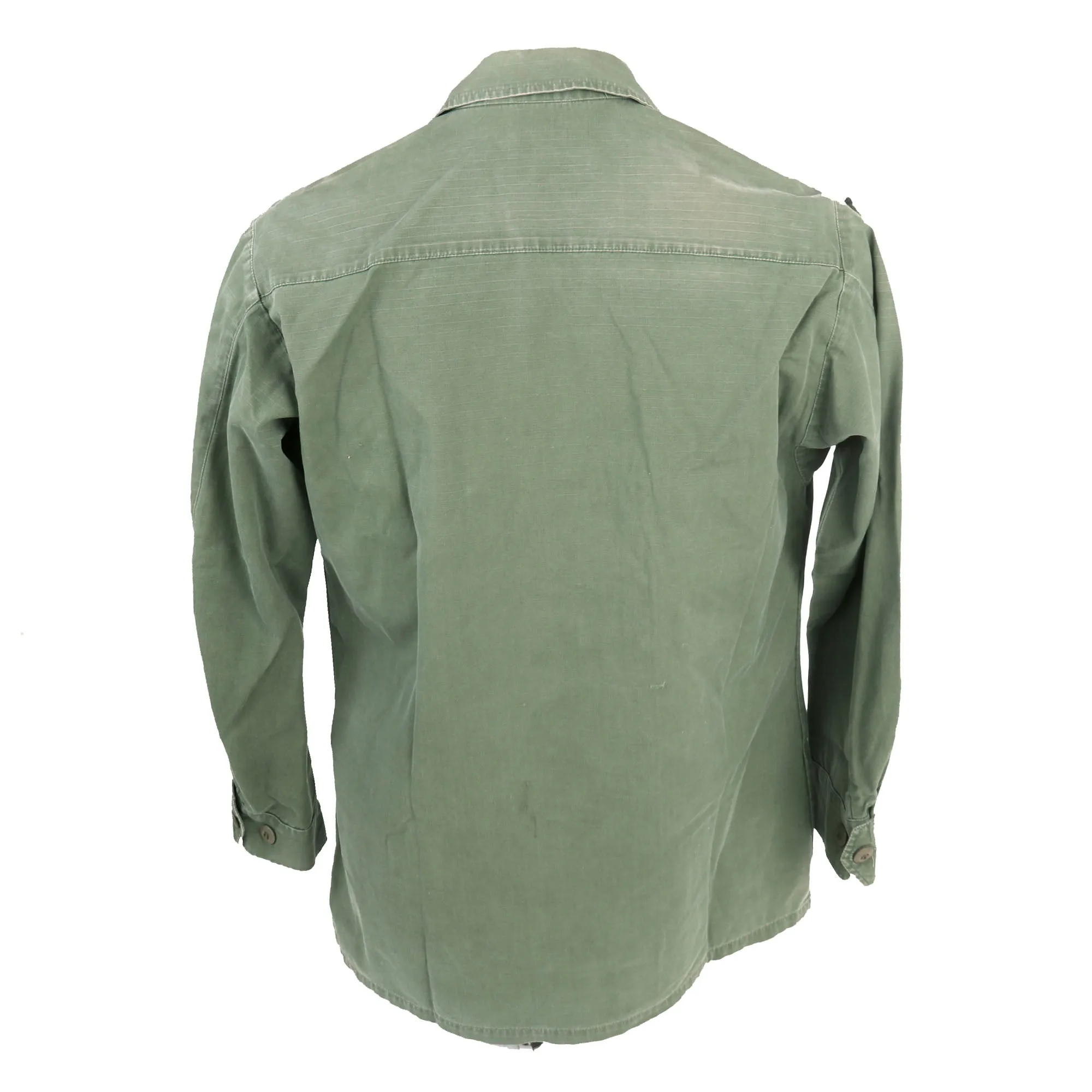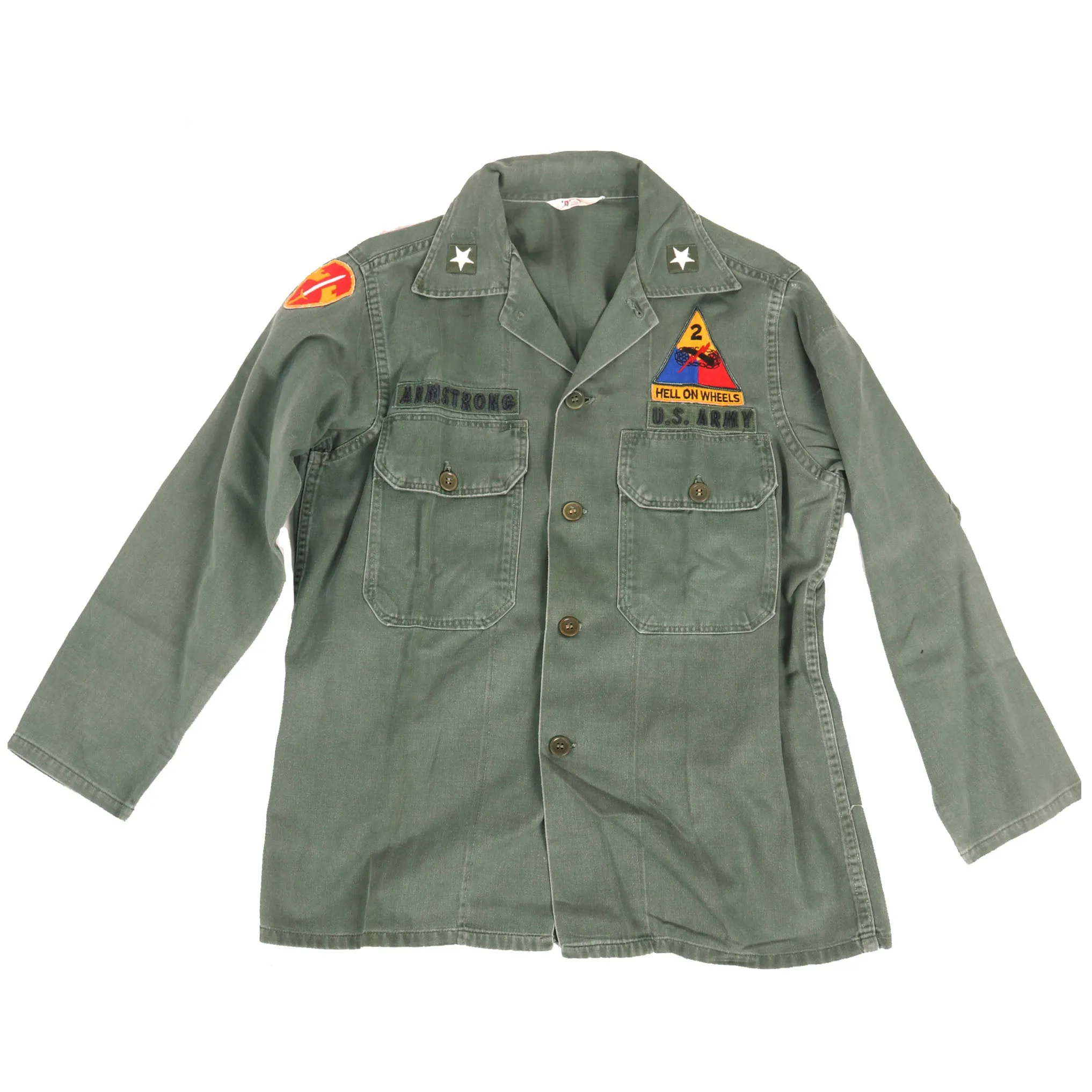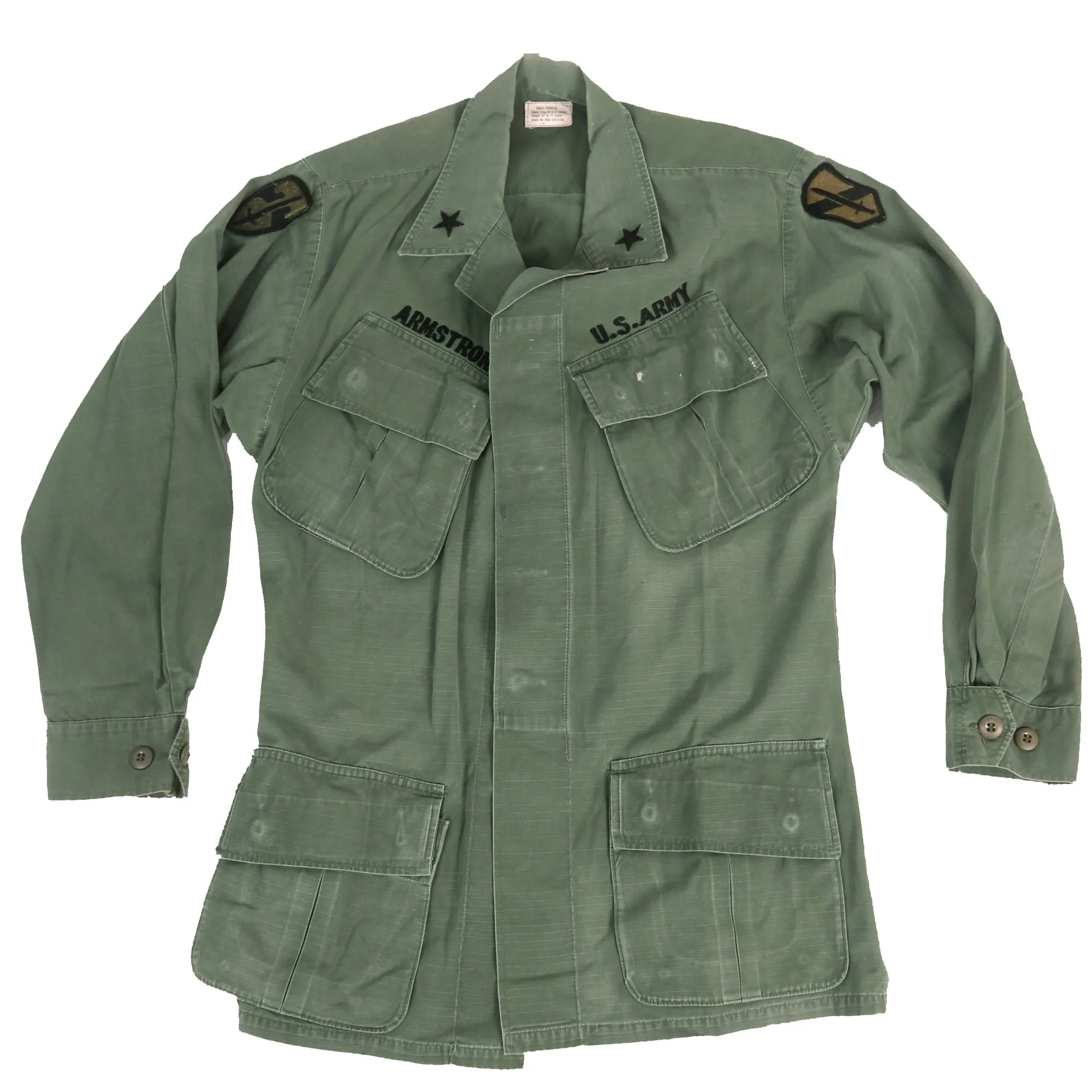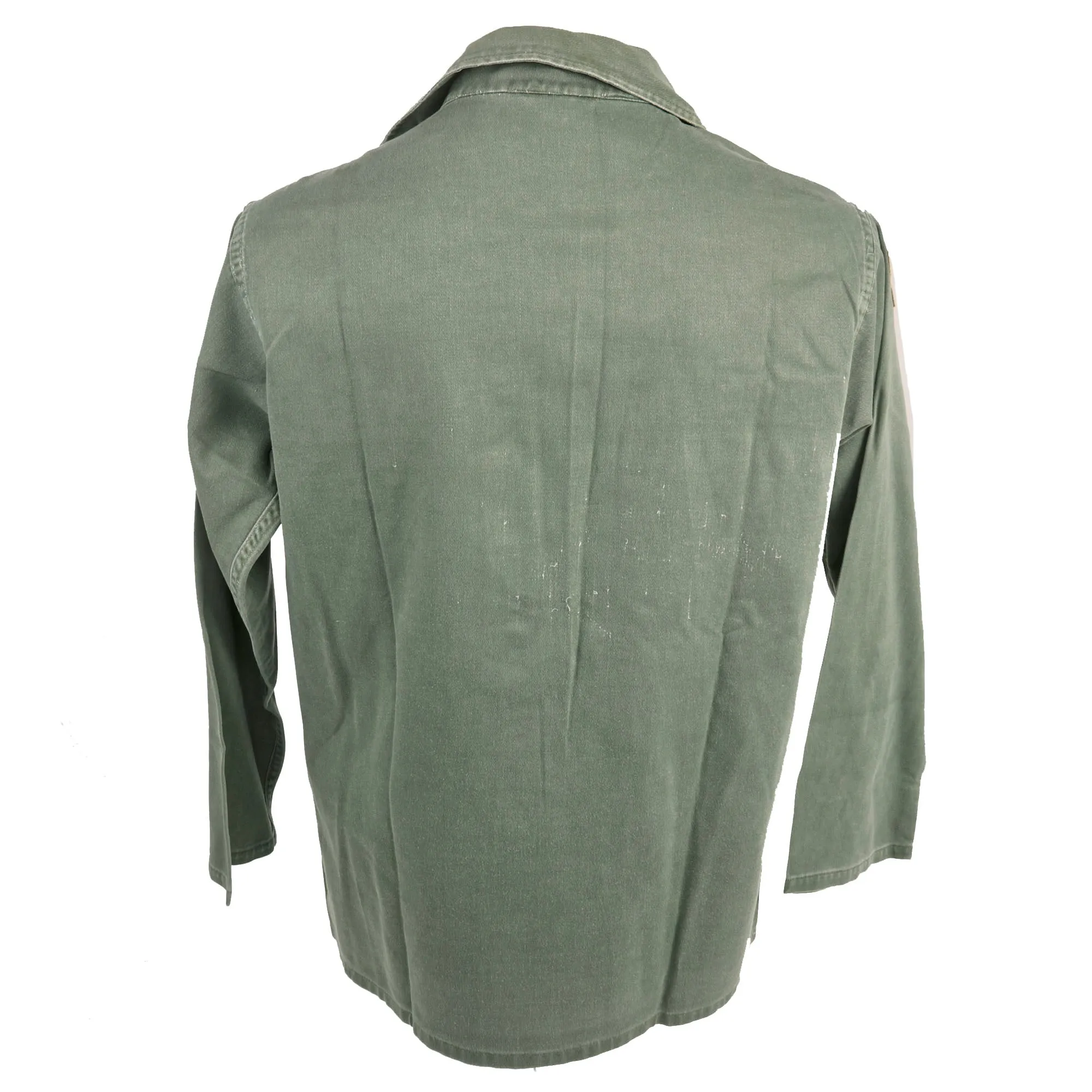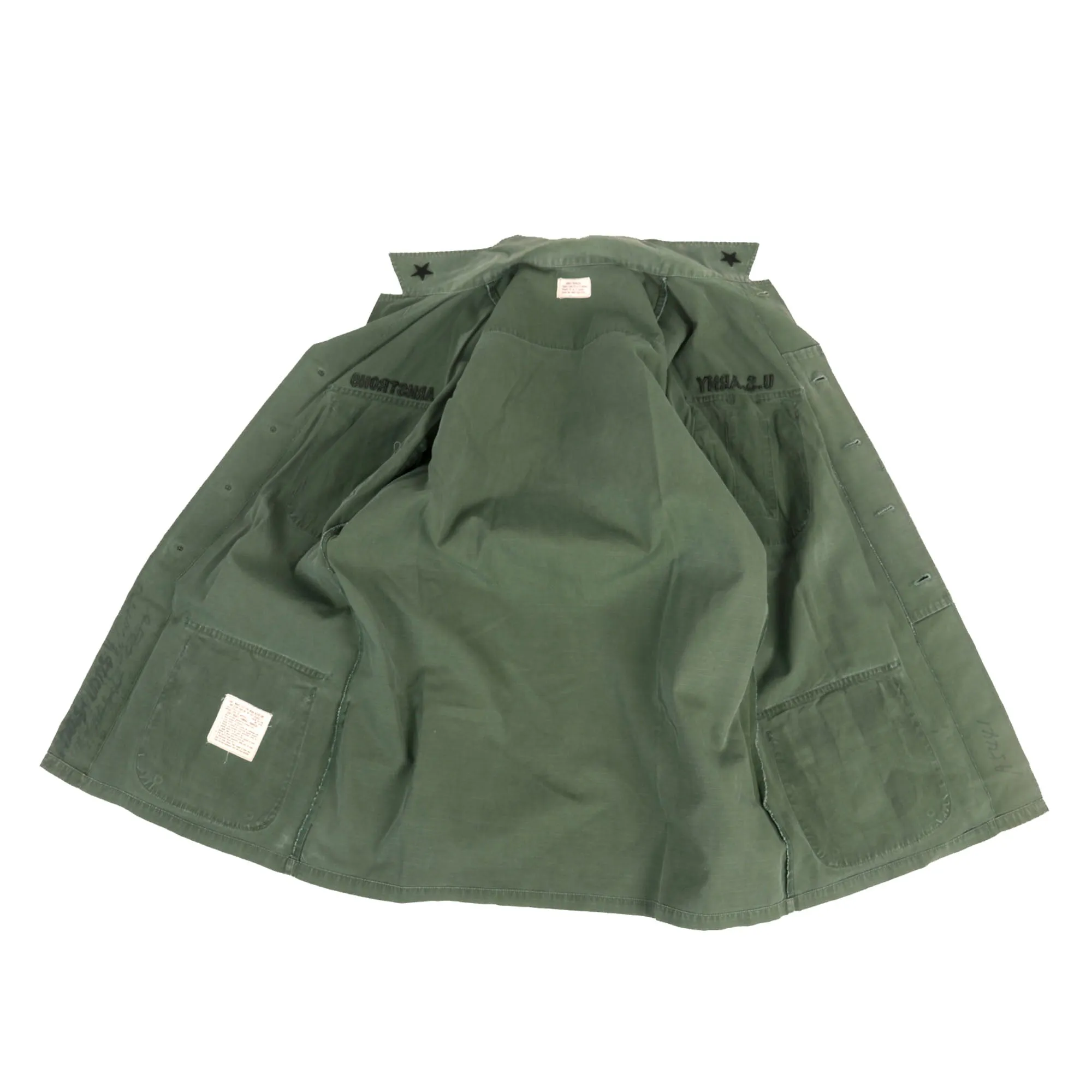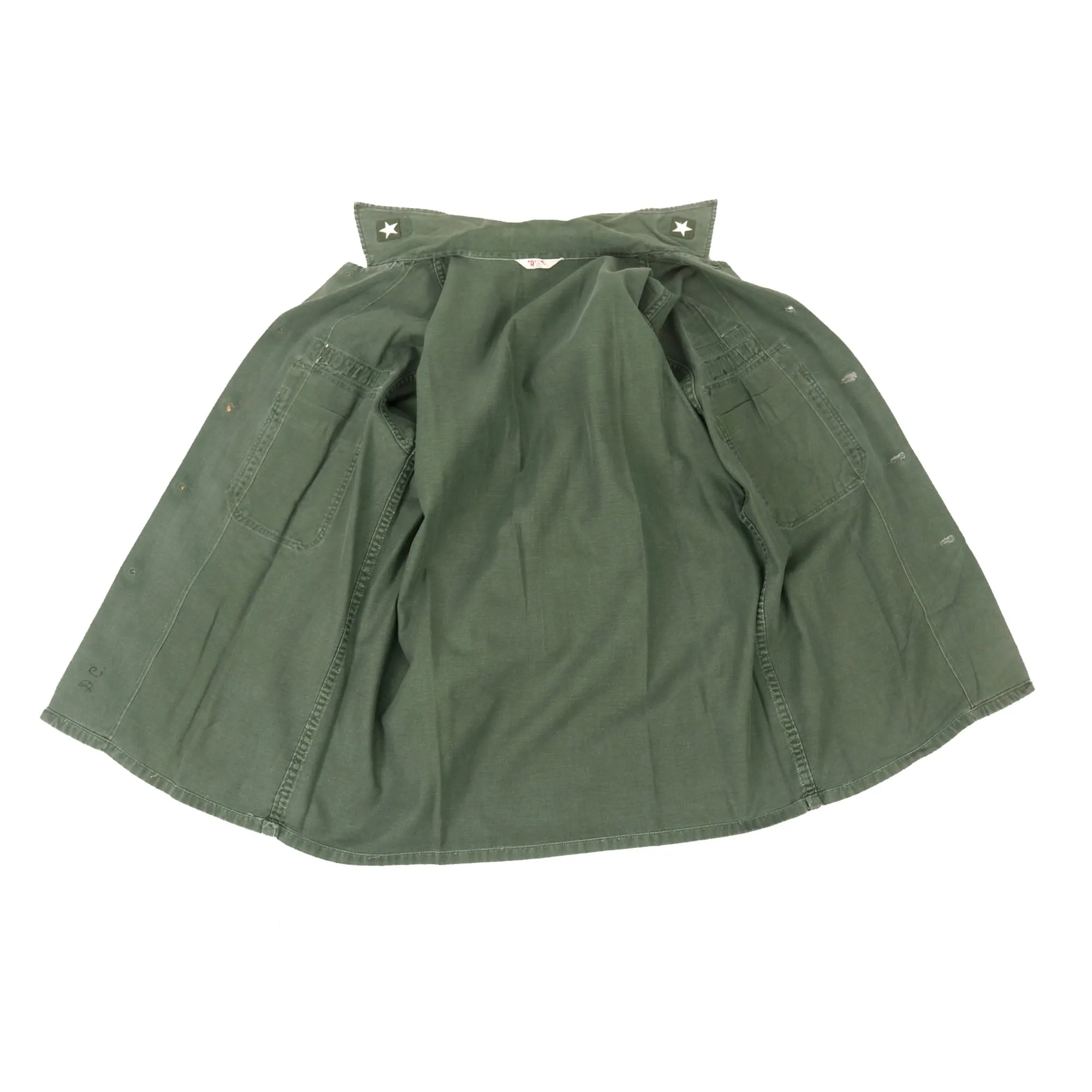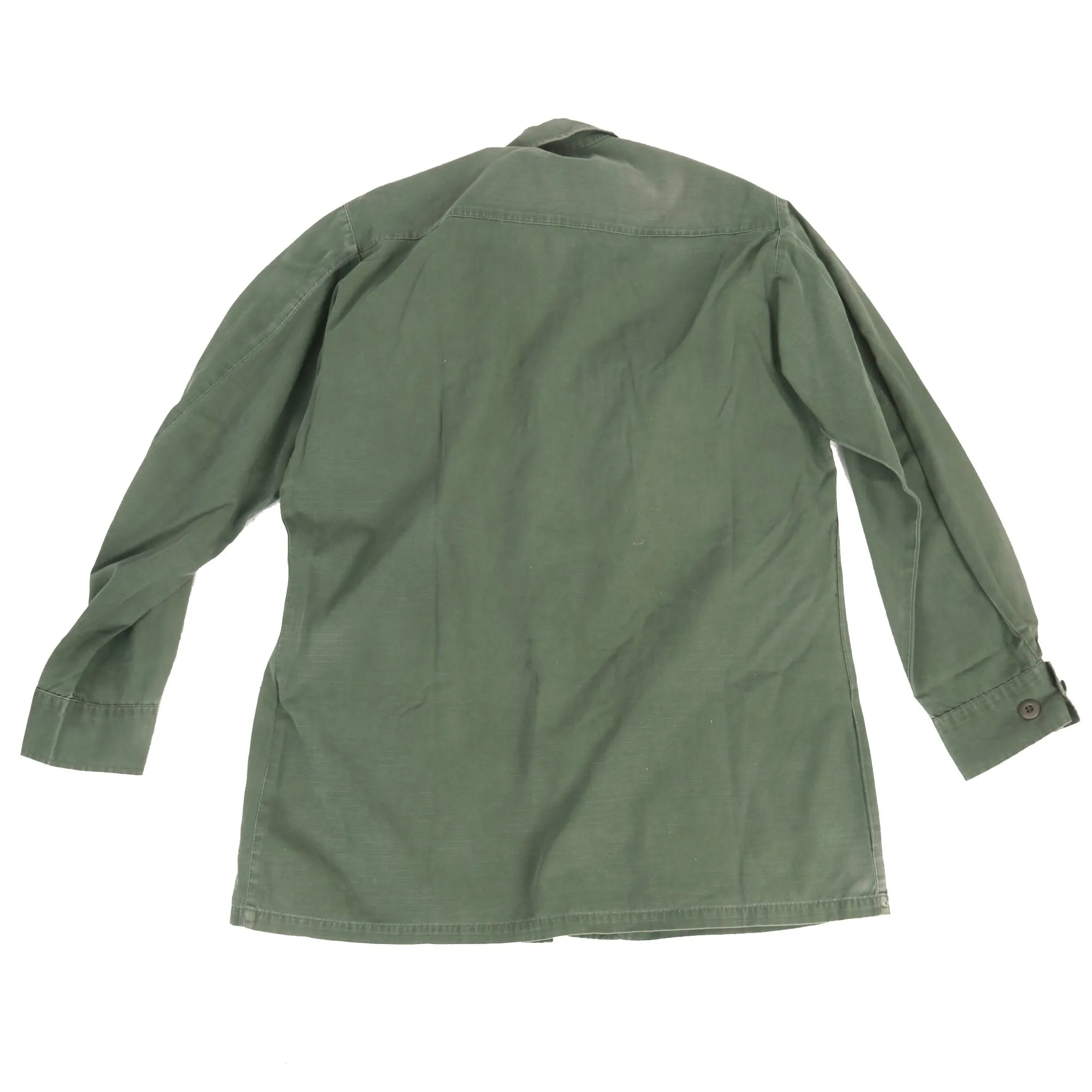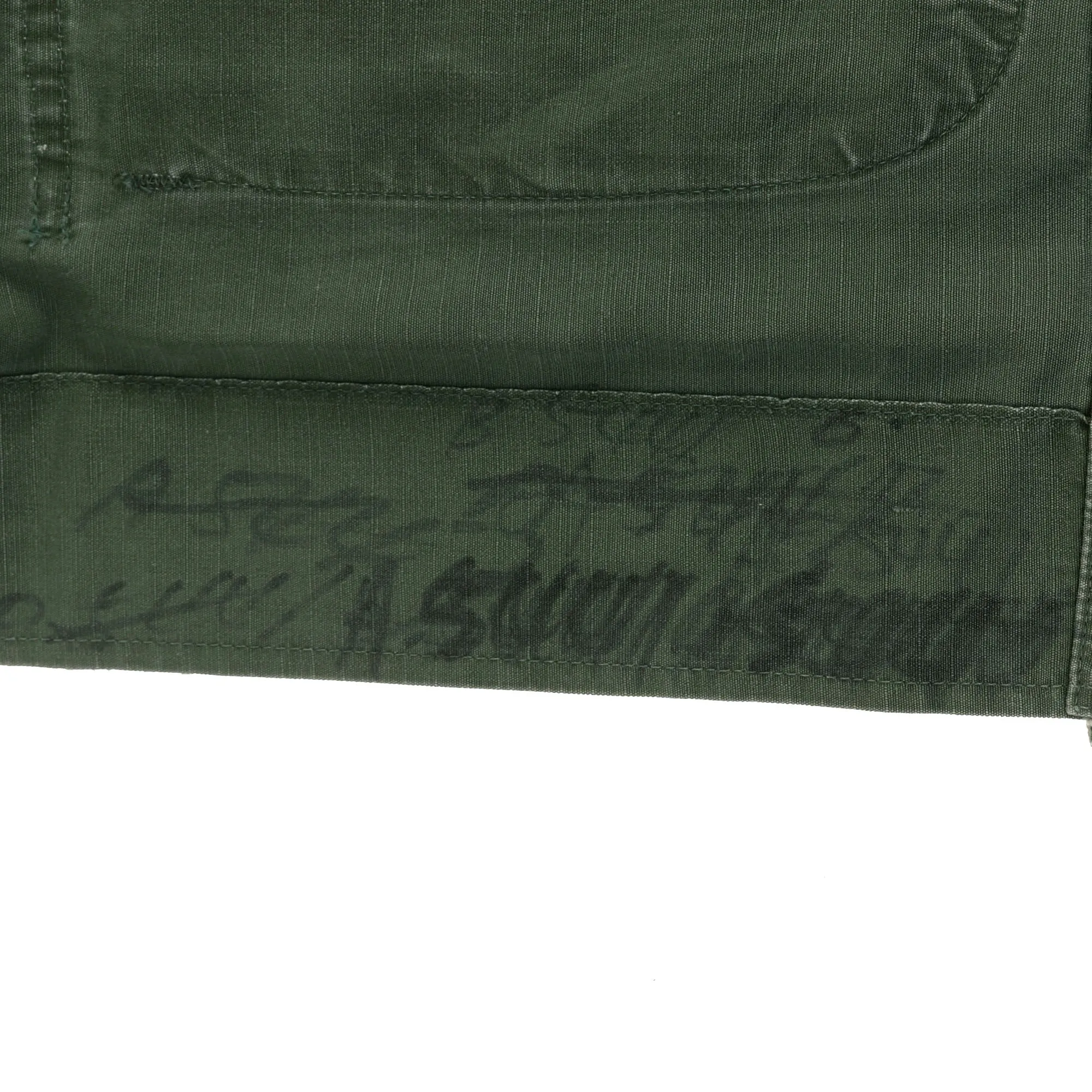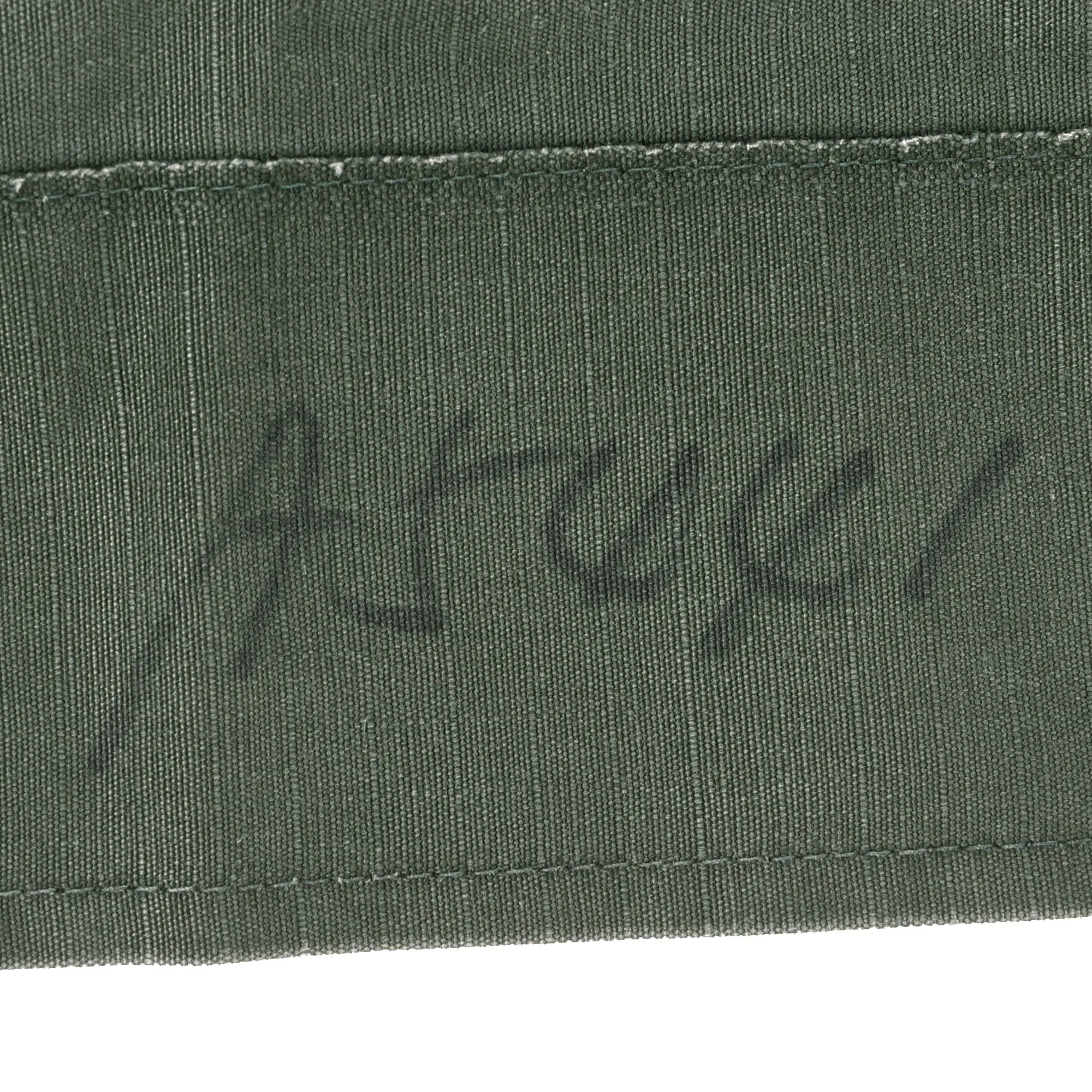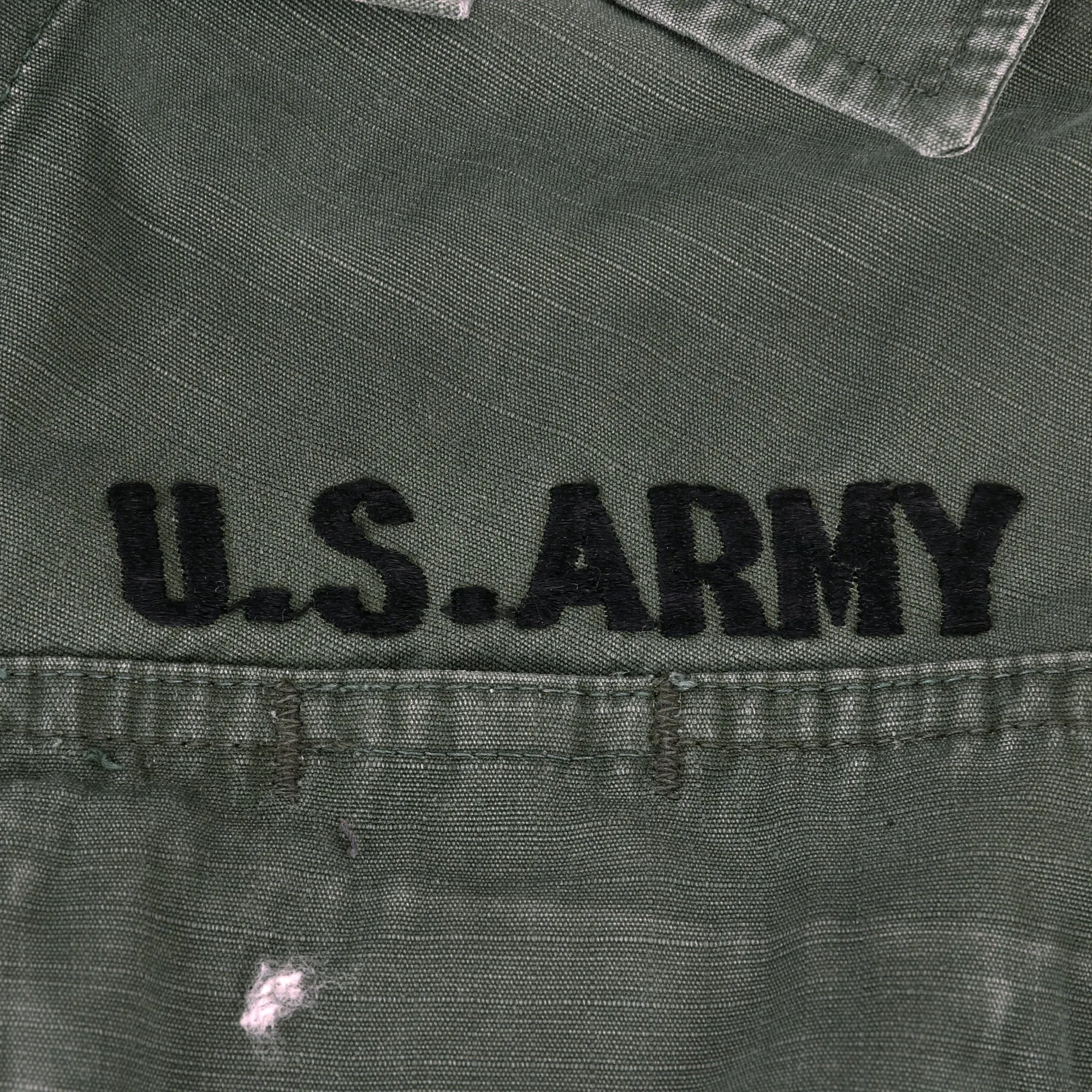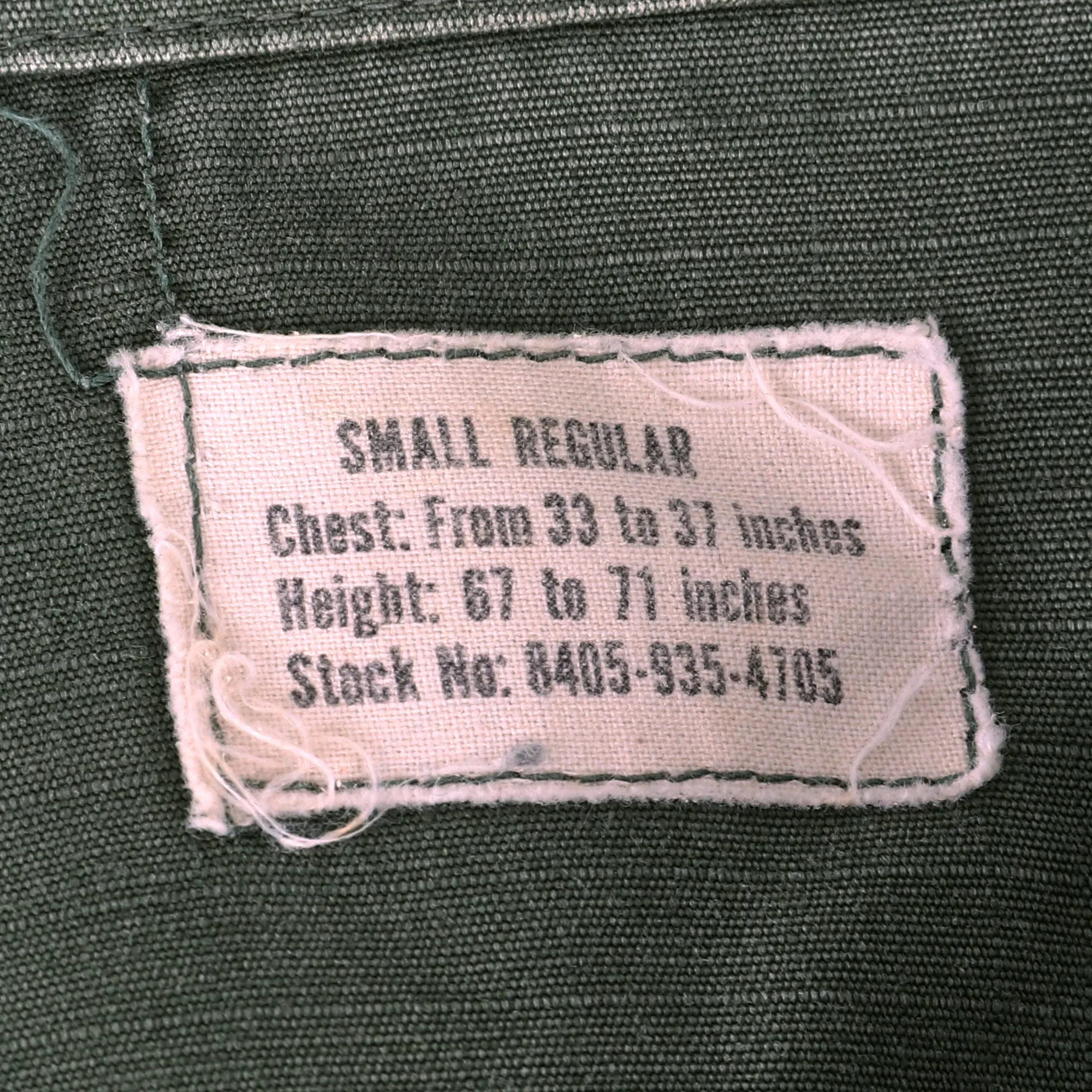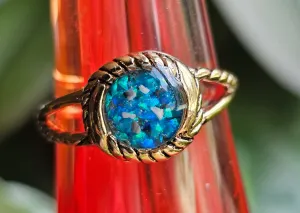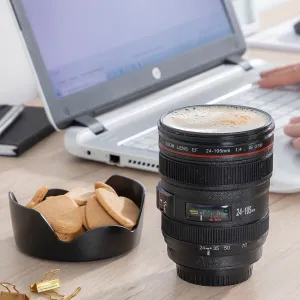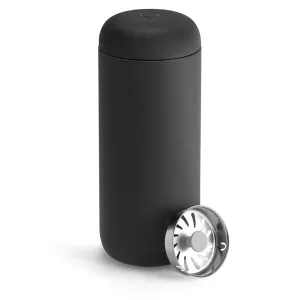Original Items: One-Of-A-Kind: This is a wonderful uniform grouping that once belonged to Brigadier General DeWitt Clinton Armstrong III. General Armstrong served as the Chief U.S. Military Assistance Command, Vietnam (MACV) Planner in Saigon during the critical buildup during his first tour in Vietnam from 1965 to 1966. The uniform grouping is a fantastic set of OG-107s and features lovely insignia, some of which are "direct embroidered" onto the uniform, a common request made by officers to local tailor shops while serving in Southeast Asia. The grouping consists of (2) sets of OG-107 shirts and (2) pairs of trousers.
Armstrong served as the executive officer of the 94th Cavalry Squadron during World War II. He was awarded the Purple Heart, Bronze Star, and received a battlefield promotion to Major. During the critical buildup in Saigon, he served as the chief MACV planner during his first tour of duty in the Vietnam War (1965-1966), and returned to Vietnam in 1970. His accolades include the Distinguished Service Medal, Legion of Merit with 3 OLC, Air Medals with three OLC, Commendation Medals, Korean Order of Chung Me, the French Croix de Guerre with palm, and several Vietnamese medals.
The Uniforms In This Grouping:
- OG-107 “Type III” Uniform Set: The third pattern fatigues which were introduced in late 1966 / early 1967 were a simplified version of the second pattern. The coat lost its side take up tabs, gas flap, and shoulder epaulets. This pattern is slightly more complicated as it was issued in two classes. Class I was OG-107, or green and Class II was ERDL Camouflage in either green dominant or brown dominant depending on the region they were being issued to.
This lovely Third Pattern “Class 1” jungle coat is in lovely, service worn condition with great insignia. The insignia present includes 1st Field Force & MACV Shoulder Sleeve Insignia with direct embroidered Name (ARMSTRONG), Branch (U.S. ARMY) and rank insignia, more than likely done while in Saigon.
The tag is still present and reads as:
SMALL REGULAR
CHEST: FROM 33 TO 37 INCHES
HEIGHT: 67 TO 71 INCHES
STOCK NO: 8405-935-4705
- OG-107 “Type I” Uniform Set: The uniform set itself is a “Type I” which was worn from 1952 to 1963. The first "Type I" model was introduced in 1952 and remained virtually unchanged through its 10-year production run. The shirt features a sleeve with no true cuff or buttons; it was simply a straight sleeve with a simple hem at the cuff. The shirt's two chest pockets and the trousers rear two pockets had a rectangular pocket flap that buttoned. The buttons were a "dished" style and most of the 1950s production were a dark brown color like this one while the majority of the 1960s production were dark green. The trousers also had a simple adjustment tab on the waist that could be buttoned. The shirt and trousers were also sized in groups (Small, Medium, Large, etc.) This model was replaced in April 1963 when specifications came out for the second model.
This lovely example features patched insignia only and is not direct embroidered as the previous set. The insignia includes a MACV shoulder sleeve insignia on the right shoulder, Brigadier General Stars on each collar, 2nd Armored Division patch on the front left breast, name and service tapes above the breast pockets. The interior tag is still present and reads as B.V.D. / BRAND / 100% COTTON.
A fantastic uniform grouping that comes more than ready for further research and display.
Approximate Measurements:
Set #1
Shirt-(Small Regular)
Chest : From 33" to 37"
Height : From 67" to 71"
Pants-(Medium Regular)
Waist: From 31" to 35"
Inseam: From 29.5" to 32.5"
Set #2
Collar to shoulder: 9.5"
Shoulder to sleeve: 22”
Shoulder to shoulder: 18”
Chest width: 20"
Waist width: 20"
Hip width: 20"
Front length: 30"
Pants
Waist: 34"
Inseam: 33"
The Following Is A Biography Written By Friends of Armstrong:
DeWitt C. Armstrong III
Interred in West Point Cemetery, West Point, NY
“DeWitt Clinton Armstrong III, born in the Panama Canal Zone, was destined by heritage and intellect to be an Army officer and general like his father. In our 50-year Howitzer, he describes himself as a "soldier's son." That imperative affected all that he was and all that he did. A consciousness of military heritage was an essential part of him, not as a burden but in a way of inspiration and sense of duty.
His academic brilliance showed early. After graduating from high school, "Dee" was too young to enter West Point, so he spent a year at the Citadel and then a year at Sully's Preparatory School, preparing for the very special West Point entrance exams. While living in the Washington, DC, area, Dee’s tennis ability put him on the first Junior Davis Cup Team at the Army-Navy Country Club. That skill and conditioning would sustain him over his life.
His leadership also surfaced early. The plebes in the 5th New Cadet Company were delighted to find a fellow member who could explain the vagaries of the Blitz cloth, Noxon, and polish. During the academic year, he coached, guided, and earned a series of bars below his expert marksmanship badge. He became the natural company commander of E-2 when the Corps expanded. On Graduation Day, he was ninth in our class and took the first slot in Armored Infantry (Armor had not yet been established as a branch).
Ft. Knox led to the 14th Armored Division and to combat in Europe. As S-2 of a combat command, Dee became executive officer of the 94th Cavalry Squadron, when his predecessor in that post was killed in action. He learned of his new job while in a ditch under fire himself. By the end of the war, Dee had the Purple Heart for wounds, a Bronze Star (rare in those days), and battlefield promotion to major. Even as he approached the tender age of 80, the details of WWII combat remained clear as he often spoke of those days, the battles, and friends.
Dee was one of the first Army men to join the nuclear energy program at Sandia and later in Washington, DC. Only the smartest were sent, but the security clearances required in nuclear arena kept Dee from fighting in Korea, which upset him because he felt that when our country was at war, one went to fight! In 1952, the Army did permit him to command, in succession, two cavalry squadrons in the 14th and 2d Cavalry Regiments in Germany.
After his return to the States, Dee earned an MA, MPA, and Ph.D. in political science from Princeton University. It was typical of him that he never sought credit for work he did at the national level. But a series of policy shifts bear his mark as initiator, such as the shift from massive retaliation to graduated response. He was first an Army planner, then a Department of Defense planner during the 1960—62 crises over Berlin and Cuba; finally the first military member of the State Department’s Policy Planning Council.
But another war loomed. This time, after graduating from the National War College, Dee went! In 1965- 66, he was the chief MACV planner in Saigon during the critical buildup. That was his first Viet Nam tour.
Dee returned to the States to command (brigade and ADC) in the 2d Armored Division at Ft. Hood, where he made brigadier general. Returning to Alexandria, he became one of three generals in ACSI (Army Intelligence).
Then, in 1970, he returned to Viet Nam.
Here, in the waning years of our commitment, Dee closed out the U.S. effort as the commanding general of the Advisory Group to the Vietnamese III Corps and, finally, as the commanding general of U.S. Army Forces with 22,000 men and 550 helicopters. In earlier days, a force that size would have easily justified a major general’s rank, but the American people were tired of war. Little attention was paid to problems in that far-off land, or to promotions for those closing us down. In 1971, Dee returned home to become the commanding general at Ft. Devens in a liberal and anti-war commonwealth. He did a brilliant job. A Distinguished Service Medal granted on his retirement at 30 years paid tribute to that.
Earlier, in 1948, after a seven-year courtship at West Point and on two continents, Dee married Kate Johnson, also an "Army brat" herself, who loved Army life and served its ideals as much as Dee. They were blessed with two children: Dewey in 1951 and Kate Ellen in 1956.
Retirement did not bring lack of activity. Back in Alexandria, Dee taught public administration for master and doctoral students and became a consultant for the National Academy of Public Administration. He also served on the vestry of Emmanuel Episcopal Church in Alexandria and volunteered time with Meals on Wheels. As a former class president, he was a key player involved in the wording now on the wall of the Constitution Corner at West Point.
As the years passed, he spent more time playing tennis and studying history. As a boy, he was standing on the corner in Shanghai when the Japanese took over and saw the Scottish troops swing down the street to the sound of the pipes. That was the moment when he knew what it meant to be an Armstrong. A lifelong interest in Scottish history led to the boards of the Armstrong clan organizations in the U.S. and Scotland and visits to his ancestral homeland.
Dee lies with his father, mother, brother, and sister in the West Point Post Cemetery. He leaves his wife of 53 years, son Dewey (DCAIV), daughter Kate Ellen, and granddaughter Hannah. His soldierly record won him the Distinguished Service Medal, three awards of the Legion of Merit, a Bronze Star, the Purple Heart, three Air Medals, Commendation Medals, Korean Order of Chung Me, the French Croix de Guerre avec palm, and several Vietnamese medals.
Rest well, old friend. You were a great soldier!
KJA and WAK”
The OG-107 uniform was the standard work and combat uniform for all branches from 1952 to 1989. It was made of 8.5-ounce cotton sateen and had a button front shirt with two patch pockets and straight-legged trousers. It was eventually replaced by the Battle Dress Uniform (BDU) in the 1980s.




